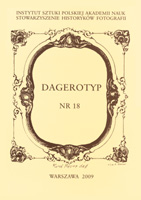Misje fotograficzne Henryka Poddębskiego - od Wileńszczyzny po Śląsk, od Pomorza po Huculszczyznę (część II)
The photographic voyages of Henryk Poddębski – from the Vilna Region to Silesia, from Pomerania to the Hutsul Region (part II)
Author(s): Małgorzata FlorczakSubject(s): Photography
Published by: Instytut Sztuki Polskiej Akademii Nauk
Keywords: photography; Polish photography; vintage photography; history of photography; old photographic technique; Poddębski; Henryk; documentary photography; Polish Sightseeing Society
Summary/Abstract: The text follows on from an article published in Dagerotyp, 17, titled “Photographic voyages of Henryk Poddębski – a historical outline, beginnings of activity (part I)”. It comprises two sections. At the beginning, reports are presented from three out of the twelve of his photographic expeditions that have been preserved, found in the archives of Mieczysław Orłowicz that are housed in the PAN Archive. The first account covers his “expedition” around Cracow and the surrounding voivodeships, which he undertook in May 1934; the next two accounts focus on his tours around the Stanisławów Voivodeship and Pokuttya in July 1938. These accounts give an overview of the exploratory-photographic expeditions of Dr. Mieczysław Orłowicz and Henryk Poddębski, which were organised under the patronage of the Ministry of Communications. Orłowicz, who was head of the tourism section, was always responsible for the organisation and planning of each such trip, whereas Poddębski’s role was to document them. Documentation from those expeditions constitutes a sizeable part of the photographer’s own archive. Thanks to Orłowicz’s descriptions, we can discern the thematic canon that guided the documentation process. In accordance with the canon, the photographs depicted urban and rural, as well as industrial architecture, public utility buildings; in addition to vedute, they photographed landscapes, the local natural phenomena and folk art. The written accounts were successfully matched to the photographs taken on those expeditions, which had been preserved in the Collection of the Art Institute and the author’s family archive. The second part of the article attempts a formal analysis, based on a selection of a few photographs. It also presents the only camera to be preserved after the war and which constituted part of the equipment used on the aforesaid expeditions.
Journal: Dagerotyp
- Issue Year: 2009
- Issue No: 18
- Page Range: 95-126
- Page Count: 32
- Language: Polish
- Content File-PDF

